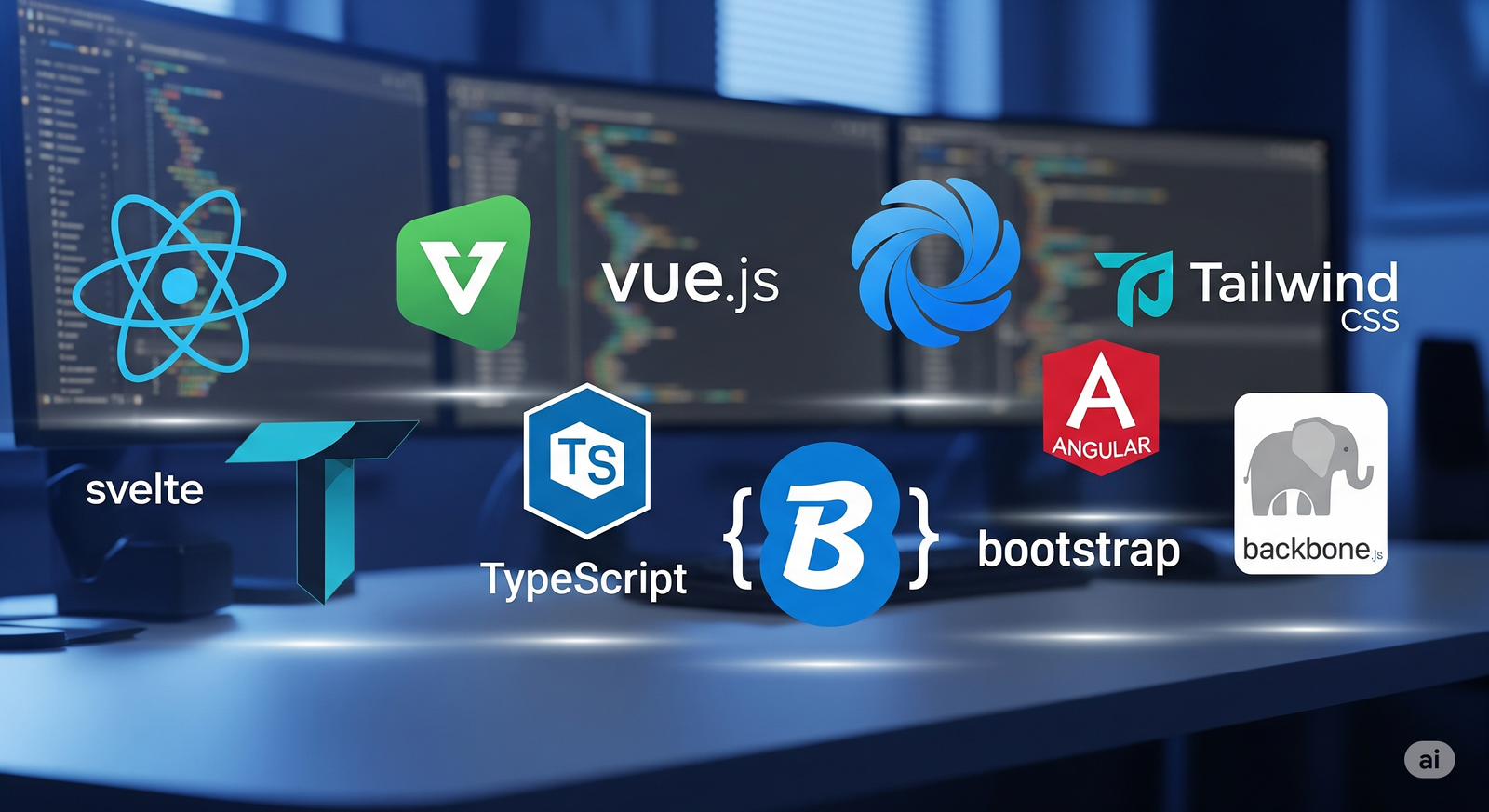Top Web Technologies For Web Development In 2025
The web development landscape is experiencing remarkable transformation as we advance through 2025. Modern web technologies are revolutionizing how we conceptualize, build, and interact with digital experiences across the internet.
Today’s cutting-edge web development technologies in 2025 extend far beyond basic functionality—they’re creating intelligent, lightning-fast, and highly personalized applications that adapt to user needs in real-time. From AI-powered development tools to instantaneous frameworks, the current generation of web design technologies is introducing developers to unprecedented possibilities.
However, with countless options available in today’s market, selecting the optimal stack can feel overwhelming. As someone deeply involved in the industry, I’ve witnessed firsthand how the right technology choices can make or break a project’s success.
This comprehensive guide will walk you through the most influential and powerful web technologies dominating 2025’s development landscape. Whether you’re planning your next project or evaluating current solutions, these insights will help you make informed decisions that drive exceptional results.
Table of Contents
Leading Front-End Web Technologies
The front-end represents users’ first interaction with any website—making technology selection crucial for success. Modern web design demands solutions that prioritize user experience, ensure rapid loading times, and encourage visitor engagement.
Here are the web technologies shaping front-end web development excellence in 2025:

React
React continues dominating the web development ecosystem through its exceptional flexibility, performance optimization, and robust community support. Originally developed by Meta (Facebook), this JavaScript library revolutionizes how developers create interactive user interfaces, particularly for single-page applications focused on delivering superior user experiences.
Why React Remains Essential for Web Development in 2025:
- Performance Excellence: React’s virtual DOM architecture enables developers to build highly dynamic interfaces without compromising speed or responsiveness
- Comprehensive Ecosystem: Tools like Next.js for server-side rendering and Redux for state management create a rich development environment
- Active Community: Continuous updates ensure React stays current with industry best practices and emerging integrations
2025 React Innovations:
React 18 introduces enhanced concurrent rendering capabilities, simplifying complex application development. React Server Components offer innovative approaches to handling data-intensive applications, significantly improving performance while reducing loading times.
React vs. Alternatives:
While React leads the market, Vue.js and Svelte present compelling alternatives worth considering for specific use cases.
Vue.js
Vue.js has established itself as a powerful yet approachable web development framework. Since its introduction, it has gained significant traction, particularly among development teams seeking flexible and scalable solutions with manageable learning curves.
Vue.js Advantages:
- Flexibility and Efficiency: Vue functions both as a targeted library for specific features and as a comprehensive framework for complex applications
- Rich Ecosystem: Tools including Vue CLI, Vue Router, and Vuex streamline development workflows
- Developer-Friendly: Gentle learning curve makes it accessible to developers at various experience levels
When to Choose Vue for Web Development:
Vue excels in projects prioritizing simplicity and rapid development cycles. It’s particularly effective for smaller to medium-sized applications where extensive front-end complexity isn’t required.
Svelte
Svelte represents a revolutionary approach to front-end web development. Unlike traditional frameworks, Svelte compiles components at build time, eliminating virtual DOM overhead and creating highly optimized applications.
Svelte’s Revolutionary Benefits:
- No Virtual DOM: Build-time compilation creates faster, more efficient applications
- Smaller Bundle Sizes: Absence of framework runtime code results in leaner applications
- Superior Performance: Direct DOM manipulation provides exceptional speed
Why Svelte Defines the Future:
Svelte’s unique architecture makes it ideal for performance-critical applications, resource-constrained environments, and edge computing scenarios where efficiency is paramount.
Tailwind CSS
While not a JavaScript framework, Tailwind CSS has transformed modern web design methodologies. This utility-first CSS framework provides low-level utility classes that developers combine to create custom designs directly in HTML.
Tailwind’s Impact on Web Design:
- Unlimited Customization: Enables unique designs without extensive custom CSS
- Responsive Design Made Simple: Built-in responsive utilities ensure seamless cross-device experiences
- Rapid Prototyping: Quick design iterations accelerate development timelines
Tailwind vs. Traditional Frameworks:
Unlike component-heavy frameworks like Bootstrap, Tailwind offers granular control over design elements, preventing the templated appearance common in traditional solutions.
Angular
Google-maintained Angular remains a cornerstone of enterprise web development. Its comprehensive architecture, TypeScript integration, and robust feature set make it ideal for large-scale applications requiring structure and maintainability.
Angular’s 2025 Strengths:
- Complete Framework: Includes built-in dependency injection, routing, and form handling
- TypeScript Native: Enhanced code predictability and maintainability
- Enterprise Focus: Extensive tooling and scalable architecture support complex business applications
Angular Use Cases:
Angular excels in enterprise environments requiring formal development approaches, such as e-commerce platforms, content management systems, and data-intensive dashboards.
TypeScript
TypeScript enhances JavaScript with static typing, dramatically improving code quality, readability, and maintainability. By catching errors during development rather than production, it has become indispensable for serious web development projects.
TypeScript’s Critical Role in 2025:
- Error Prevention: Compile-time error detection significantly reduces runtime issues
- Enhanced Scalability: Particularly valuable for large, complex codebases
- Universal Framework Support: Compatible with React, Vue, Angular, and other popular web technologies
TypeScript Applications:
Essential for long-term projects requiring reliability and maintainability. Development tools like autocompletion and refactoring capabilities boost productivity significantly.
Bootstrap
Bootstrap continues leading responsive, mobile-first web development. Its pre-designed components and CSS utilities enable developers to create professional, responsive websites with minimal custom coding.
Bootstrap’s Continued Relevance:
- Pre-Built Components: Comprehensive library of navigation bars, buttons, forms, and layout elements
- Responsive Grid System: Flexible layouts adapt seamlessly across screen sizes
- Integrated Functionality: Combined CSS and JavaScript capabilities simplify interactive element development
Bootstrap Applications:
Perfect for projects requiring clean, professional aesthetics without extensive custom CSS development.
Backbone.js
Backbone.js provides lightweight structure for web development projects through its MVC architecture. This minimalist library offers essential tools for building dynamic applications while maintaining developer control.
Backbone.js Advantages:
- Flexibility and Simplicity: Lightweight approach allows developers to include only necessary features
- Architectural Control: Complete control over application structure and implementation
- RESTful API Integration: Seamless synchronization between front-end and backend data
Essential Backend Web Technologies
Selecting appropriate backend web development technologies in 2025 is crucial for building efficient, scalable, and secure applications. Let’s explore the leading solutions:

Node.js and Deno
Node.js revolutionized backend web development by enabling JavaScript server-side execution. Deno, created by Node.js’s original developer, addresses security concerns while providing native TypeScript support.
Node.js 2025 Advantages:
- Asynchronous Architecture: Non-blocking processing handles multiple concurrent requests efficiently
- Framework Ecosystem: Express.js offers minimalist solutions while Nest.js provides enterprise-grade structure
Deno’s Evolution:
Deno addresses Node.js security limitations through default security measures and native TypeScript support, making it ideal for security-conscious applications.
Python and Django/FastAPI
Python maintains its dominance in web development through exceptional versatility and readability. Django and FastAPI represent Python’s most powerful frameworks, each serving distinct development needs.
Python’s Continued Success:
- Developer-Friendly Syntax: Clean, readable code accelerates development and maintenance
- Extensive Libraries: Vast ecosystem supports machine learning, data analysis, and specialized integrations
Framework Selection:
- Django: Comprehensive framework with built-in ORM and templating for full-stack applications
- FastAPI: Asynchronous framework optimized for high-performance API development
Ruby on Rails
Rails remains a mature, beloved web technology among developers seeking rapid development cycles. Its convention-over-configuration philosophy makes it particularly effective for MVPs and startup projects.
Rails in 2025:
- Rapid Development: Pre-configured features and scaffolding accelerate application deployment
- Startup Favorite: Proven success with companies like GitHub, Shopify, and Airbnb
PHP and Laravel
Despite misconceptions about PHP’s relevance, frameworks like Laravel demonstrate its continued evolution and capability in modern web development.
PHP’s Enduring Value:
- Widespread Hosting Support: Universal availability and cost-effective deployment options
- Laravel Enhancement: Modern framework brings sophisticated features to PHP development
Laravel Features:
Comprehensive routing, middleware, and authentication systems make it suitable for complex web development projects.
Java
Java remains one of the most reliable choices for enterprise web development in 2025, offering unmatched portability, scalability, and security for complex applications.
Java’s Enterprise Advantages:
- Platform Independence: “Write once, run anywhere” philosophy ensures deployment flexibility
- Scalability: Designed for high-performance applications requiring reliability
- Mature Ecosystem: Frameworks like Spring and Hibernate simplify backend development
JavaScript (Server-side)
JavaScript’s versatility extends beyond front-end development through Node.js, enabling full-stack development with a single language.
Server-side JavaScript Benefits:
- Unified Development: Single language across entire stack reduces context switching
- Event-Driven Architecture: Asynchronous processing excels in real-time applications
- Extensive Ecosystem: Rich library ecosystem supports diverse development needs
Mobile App Branding is done perfectly by YAAM Web Solutions – delivering comprehensive full-stack JavaScript solutions for modern businesses.
Emerging Web Development Trends for 2025
Understanding current trends in web development technologies in 2025 helps developers stay competitive and innovative:
Key Trends Reshaping Web Development:
| Trend | Impact on Web Development |
|---|---|
| AI-Driven Development | Automated code generation, debugging, and testing capabilities |
| Voice Search Optimization | Web design adapted for voice-activated interactions |
| WebAssembly (Wasm) | High-performance code execution in browsers using multiple languages |
| Edge Computing | Reduced latency through serverless architecture and distributed processing |
| Micro-Frontends | Modular front-end applications enabling independent team development |
| Progressive Web Apps | Enhanced mobile experiences, particularly in low-connectivity areas |
| Low-Code Development | Accelerated application development with minimal coding requirements |
| Blockchain Integration | Decentralized applications and enhanced security protocols |
| Dark Mode Standardization | Improved accessibility and energy efficiency across platforms |
| Enhanced Cybersecurity | Advanced security protocols including MFA and Zero Trust architecture |
AI-Driven Development Revolution
Artificial intelligence is transforming web development workflows through automated code generation, intelligent debugging, and sophisticated testing capabilities. Tools like GitHub Copilot and OpenAI Codex accelerate development while reducing errors.
Voice Search Optimization
With increasing adoption of smart speakers and voice assistants, web design must accommodate voice-based interactions. Voice-optimized websites provide better user experiences and improved search rankings.
WebAssembly Performance Enhancement
WebAssembly enables high-performance applications within browsers using languages like Rust, C, and C++. This technology opens new possibilities for computationally intensive web development projects.
Progressive Web Apps Growth
PWAs continue gaining popularity by offering app-like experiences through web browsers. Features like offline functionality, push notifications, and installability make them cost-effective alternatives to native applications.
According to Statista’s latest report, the global web development market is expected to reach $89 billion by 2027, driven by these emerging technologies and trends.
Why Choose YAAM Web Solutions for Your Web Development Needs
As web development technologies in 2025 continue evolving rapidly, partnering with experienced professionals becomes essential for project success. YAAM Web Solutions stands as a leading top web development company specializing in cutting-edge solutions that leverage the latest web technologies.

Our Comprehensive Web Development Services:
Full-Stack Development Expertise:
- Modern front-end frameworks (React, Vue, Angular, Svelte)
- Robust backend solutions (Node.js, Python, Java, PHP)
- Database design and optimization
- Cloud deployment and scaling
Advanced Web Design Solutions:
- Responsive, mobile-first design approaches
- User experience optimization
- Performance enhancement strategies
- Accessibility compliance standards
Emerging Technology Integration:
- AI-powered development tools
- Progressive Web App development
- Voice search optimization
- WebAssembly implementation
Why YAAM Web Solutions Leads the Industry:
Proven Track Record: Our portfolio demonstrates successful implementation of diverse web development projects across industries, from startups to enterprise solutions.
Technology Leadership: We stay at the forefront of web development technologies in 2025, ensuring your projects leverage the most advanced and effective tools available.
Client-Centric Approach: Understanding your unique business requirements allows us to recommend optimal technology stacks that align with your goals and budget.
Comprehensive Support: From initial consultation through deployment and ongoing maintenance, we provide end-to-end web development services.
Quality Assurance: Rigorous testing protocols ensure your applications meet the highest standards for performance, security, and user experience.
Competitive Pricing: Cost-effective solutions deliver exceptional value while incorporating the latest web technologies and industry best practices.
Ready to transform your digital presence with cutting-edge web development? Visit www.yaamwebsolutions.com to discover how our expertise can elevate your project to new heights.
Conclusion
The web development landscape of 2025 presents unprecedented opportunities for creating dynamic, responsive, and secure digital experiences. From AI-powered development tools to modular frameworks and advanced backend solutions, today’s web technologies offer deeper capabilities and greater diversity than ever before.
The rapid evolution of web development technologies in 2025 demands continuous learning and strategic adaptation to emerging trends. Whether you’re a developer crafting exceptional user experiences or an executive planning digital transformation initiatives, understanding these tools positions you for sustained success.
From React’s continued dominance in front-end development to the rise of WebAssembly and edge computing, the technologies we’ve explored represent the foundation of tomorrow’s web. The integration of AI, voice interfaces, and progressive web applications signals a future where web design becomes increasingly intelligent and user-centric.
As we navigate this exciting technological landscape, the key to success lies in choosing the right web technologies for your specific needs while partnering with experienced professionals who understand how to leverage these tools effectively.
The future of web development is bright, filled with possibilities limited only by our imagination and expertise. By embracing these advanced web technologies and staying informed about emerging trends, we can build digital experiences that truly transform how users interact with the web.
The time to act is now—let’s harness these powerful web development tools to create the next generation of digital experiences that will define our connected future.
Related Keywords: web development frameworks, modern web technologies, frontend development, backend development, JavaScript frameworks, responsive web design, web application development, full-stack development, web development trends 2025, progressive web apps, web development tools







